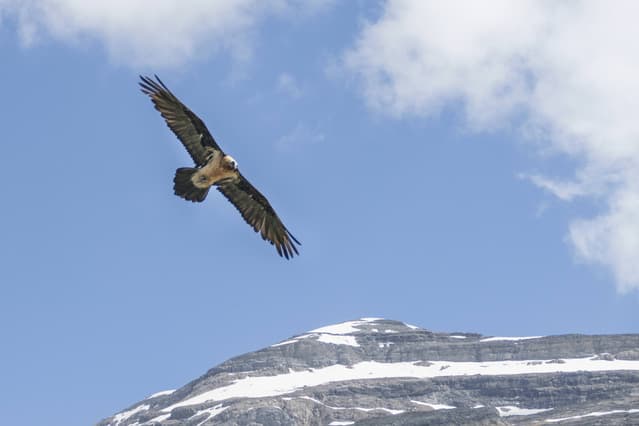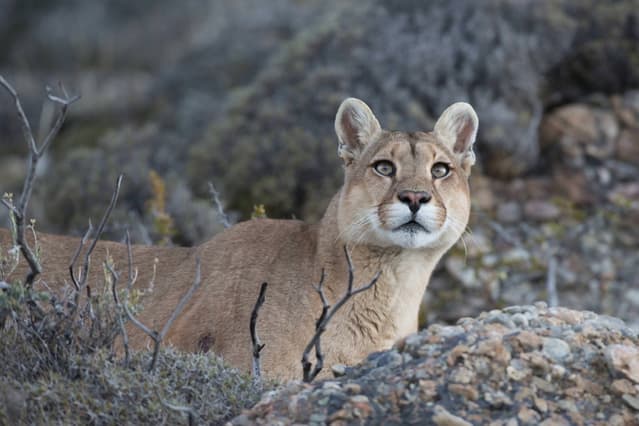Blog
The wildlife was here first
We specialise in sharing places where nature dominates, so wildlife invariably forms a part of our trips. Often it is absolutely front and centre. Our presence as visitors can often be positive, encouraging local people to conserve and value wildlife.
Saying that, many species are under threat so there’s a delicate balance to be struck. Our three co-founders reflect on their experiences alongside the wildlife of the Pyrenees, Patagonia and The Pantanal.
Working with locals: Bearded vultures in northern Spain
By Diego Martín, Pura Aventura co-founder

"If local people benefit from tourist spending, there’s a very clear incentive to protect what they are coming to see."
It was some 30 years ago that conservationists first raised the alarm about bearded vultures. A combination of trophy hunting and the use of poison to protect livestock had reduced their number so dramatically that the only viable population left in Europe was in the Pyrenees.
In 2007, I proudly joined the Bearded Vulture Foundation to help reintroduce this remarkable bird into my beloved Picos de Europa mountains. Over the course of five years we developed various projects to connect our wildlife conservation work with two other key sectors: traditional farming and tourism.
Nowadays, working hand-in-hand with the foundation allows us to provide guests with unique access to the heart of the conservation work. They meet the people who dedicate their daily lives to securing the presence of Bearded vultures in the skies for future generations. This both increases awareness about preservation and creates a source of funding to sustain the foundation.
I have always believed that a well-informed tourist can have a huge impact on the sustainability of a destination. It’s as simple as choosing where you spend your money.
If local rural populations benefit directly from tourist spending, there’s a very clear incentive to protect what the tourists are coming to see. It’s the local people after all that are fundamental to maintaining the unique wildlife and spectacular landscapes year-round.
Trip idea: Bilbao to Barcelona: Pyrenees Drive & Explore Vacation

Keeping our distance: Pumas in Torres del Paine
By Xabi Etxarri, Pura Aventura co-founder

"Surprisingly, your chances of seeing pumas in Torres del Paine have increased a lot. That leaves us with a big responsibility."
Since its creation in 1959, the vast majority of Torres del Paine National Park has never been accessible to visitors. As a result, the human impact has been concentrated in the zones visited by the public. However, the drastic increase in tourists – from 107,000 in 2005 to nearly 300,000 in 2018 is putting huge pressure on the park. Paths are deteriorating, huge amounts of litter are being generated and wildlife habitats are being altered.
The impact on the wildlife has produced some curious patterns of behaviour in some species. When I arrived in Paine in 1994 it was practically impossible to see pumas – they hid out of sight, threatened by our presence. As the number of humans increased, the pumas began to lose this fear and sightings became increasingly common.
In the last few years, I’ve seen pumas six or seven times each season – sometimes alone, but more often in small families. If you ever want to see one, your best bet is to keep your eyes peeled as you drive into the park at dawn, or out of it at dusk.
The park’s existence also means a far more abundant source of prey for the pumas. These days there are significantly more guanacos, one of the puma’s favourite food sources. So, perhaps surprisingly, your chances of seeing the elusive puma in Torres del Paine have increased quite significantly. This leaves a lot of responsibility in the hands of tour operators to encourage our visitors not to take too much advantage of this proximity. Maintaining a safe distance, keeping quiet and essentially doing all you can to blend into the landscape is important.
After all, pumas were here long before humans. We are guests in their home.
Trip idea: Torres del Paine to El Chaltén: Drive & Hike

Sharing spaces: Farming in the Pantanal
By Thomas Power, Pura Aventura co-founder

"One side farming, the other protected land. The frontier between human and animal is a clearly visible line of vegetation."
The way humans and animals interact on the edges of protected areas has always fascinated me. From standing in the scorching sun as sealions sleep on the shaded harborside benches of the Galápagos Islands to waiting patiently in a car in Costa Rica as a seemingly endless troop of Capuchin monkeys bundle and leap from one side of the road to the other, there’s something wonderful about standing aside to let nature do its thing.
In most places I’ve been, the interactions between the human and animal kingdoms seem sporadic and random, ships passing in the night. Brazil’s Pantanal wetlands are different. The vast landscape is home to enormous cattle ranches, with the main farmhouse at the heart of it all and cattle stations several hour’s ride away towards the perimeter. Long before cows and humans, the Pantanal was home to jaguar, armadillo, giant anteater, hyacinth macaw, capybara, marsh deer, caiman and any number of bird species. It still is.
What fascinates me about the Caiman Lodge is how they have drawn a line down the middle of the ranch: one side farming, the other protected land. The frontier between human and animal is a clearly visible line of vegetation. And yet, capybaras graze on the lawn, noisy macaws fill the trees, jaguars sleep in the trees and caiman wander into the cattle enclosures.
This is life in the intersection of a Venn diagram where wildlife encounters aren’t occasional, they are permanent and constant.

Our Ultimate Brazil Vacation: A Month of Wonders
-
$12,300 pp
- 26 days
Our Ultimate Brazil Vacation: A Month of Wonders

When: Anytime
Price: $12,300 per person
Duration: 26 days
Jaguar tracking and tropical snorkeling; tabletop mountains and effervescent cities - just a taste of what to expect on our greatest Brazil journey yet.






